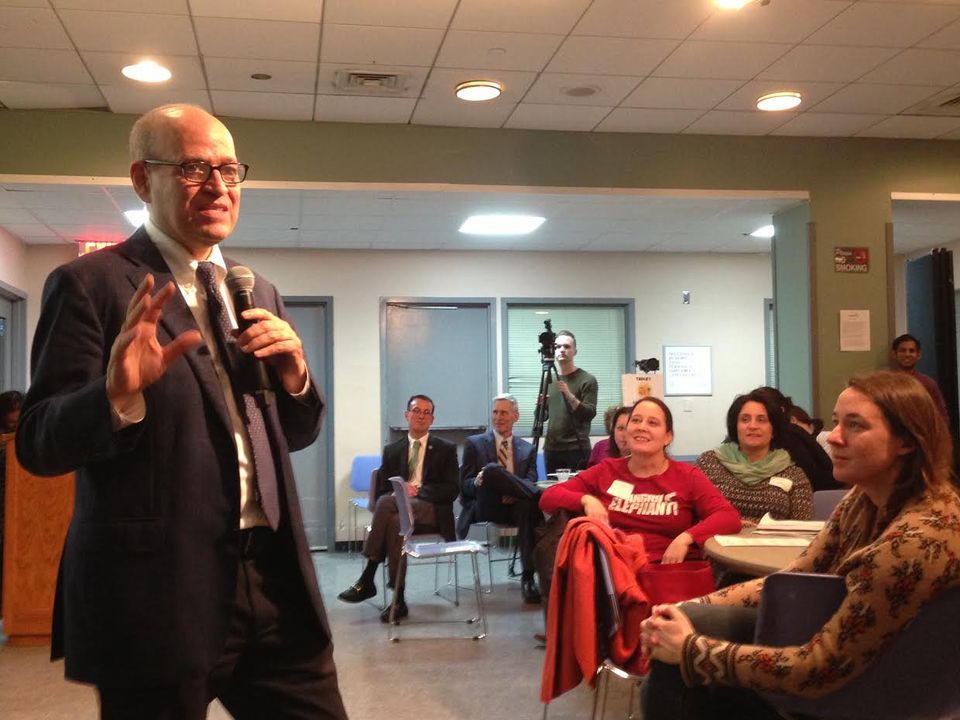Published on January 16, 2017 | silive.com | Written by Claire M. Regan

STATEN ISLAND, N.Y. — The invitation was intriguing: Show up and help shape the future of arts and culture in New York City — specifically, on Staten Island.
More than 130 local museum leaders, artists and arts advocates signed up and showed up for a boroughwide workshop organized by the city Department of Cultural Affairs (DCLA).
Held at the College of Staten Island in Willowbrook and part of the CreateNYC project, the Jan. 12 event gave participants a chance to make suggestions and offer solutions that could strengthen the arts in a borough that is no longer forgotten but often struggles to be counted in.
Deputy Borough President Ed Burke kicked off the workshop with an encouraging observation.
“Staten Island used to be the butt of many jokes,” he said. “But not anymore. When Staten Island is mentioned, we get cheers.”
CreateNYC is a citywide project that will generate a comprehensive cultural plan for the five boroughs by July 1, a mandate from Mayor Bill de Blasio and the City Council. Similar legislation is also in place in Denver, Houston, Chicago and other major cities.
Workshops have been ongoing in all boroughs since August, facilitated by Hester Street Collaborative, a non-profit agency working to transform neglected public spaces and encourage civic engagement among residents in New York City neighborhoods.
Organized into 13 tables of 10 in the Student Center, participants tackled weighty questions about equity, access, inclusion, affordability, neighborhood character and arts education. Maps of the Island on each table encouraged the groups to think inclusively.
COMMISSIONER ON HAND
For more than an hour, the room was abuzz with brainstorming as DCLA Commissioner Tom Finkelpearl and his staff visited tables to listen and observe.
The discussions were candid and provocative and often focused on challenges unique to the Staten Island arts community. Top of that list: Public transportation to the borough’s cultural destinations, especially for tourists who arrive by ferry.
“We are a physically enormous borough of half a million,” Christine Johnson said to those at her table. “It’s hard to traverse an Island 14 miles by 7 miles with miserable transportation. It’s too great a challenge.”
Meg Ventrudo, executive director of the Jacques Marchais Museum of Tibetan Art, countered with an approach that has worked for her facility, situated atop residential Lighthouse Hill.
“We go to schools when kids or groups can’t get to the museum,” she said. “Organizations have to take it to the community if the community can’t get to them.”
A shortage of exhibit and performance space on the Island was raised frequently and loudly at the tables.
“There are plenty of empty spaces, but [artists] can’t afford them,” dancer and choreographer Melissa West shared. “There is a disconnect.”
Sundog Theatre executive director Susan Fenley proposed at her table a mid-Island community arts center that would be open from morning to night to provide the space so desperately needed.
With few stages available, church halls are often the only option for the performing arts on Staten Island, she pointed out.
Laura Jean Watters urged artists to come together to attract new patrons.
“Some people get the arts because it has touched their lives in some way,” said Watters, program officer with the Staten Island Foundation and former director of the Council on the Arts and Humanities for Staten Island. “But for others, it’s an uphill struggle.”
TIME FOR TAKEAWAYS
After the brainstorming session, each table presented talking points to the commissioner and the other participants.
Reporting for her group, Lisa Dahl of New Brighton said the Island needs ambassadors and tour guides to promote Island cultural destinations and help visitors find them.
Arts education should be mandated by the Department of Education, she continued, to cultivate appreciation at a young age.
Frank Williams, producing artistic director for Staten Island Shakespearean Theater, called for “elimination of the stigma of going from south to north,” referring to borough residents south of New Dorp who are reluctant to visit North Shore museums.
Gena Mimozo said the arts must be taken more seriously.
Many people think “art is extra, it’s not important, it’s a hobby. We know that’s not true,” said the grants administrator for Staten Island Arts, suggesting satellite centers for arts education.
Commissioner Finkelpearl was pleased with the turnout and inspired by the ideas he heard.
“There are lots of opportunities for us to talk to the public, but not that many opportunities for the public to talk to us,” he said.
The workshop included a performance by the Sri Lankan Dance Company of New York and remarks by Gary Reichard, provost and senior vice president for academic affairs at the College of Staten Island.

